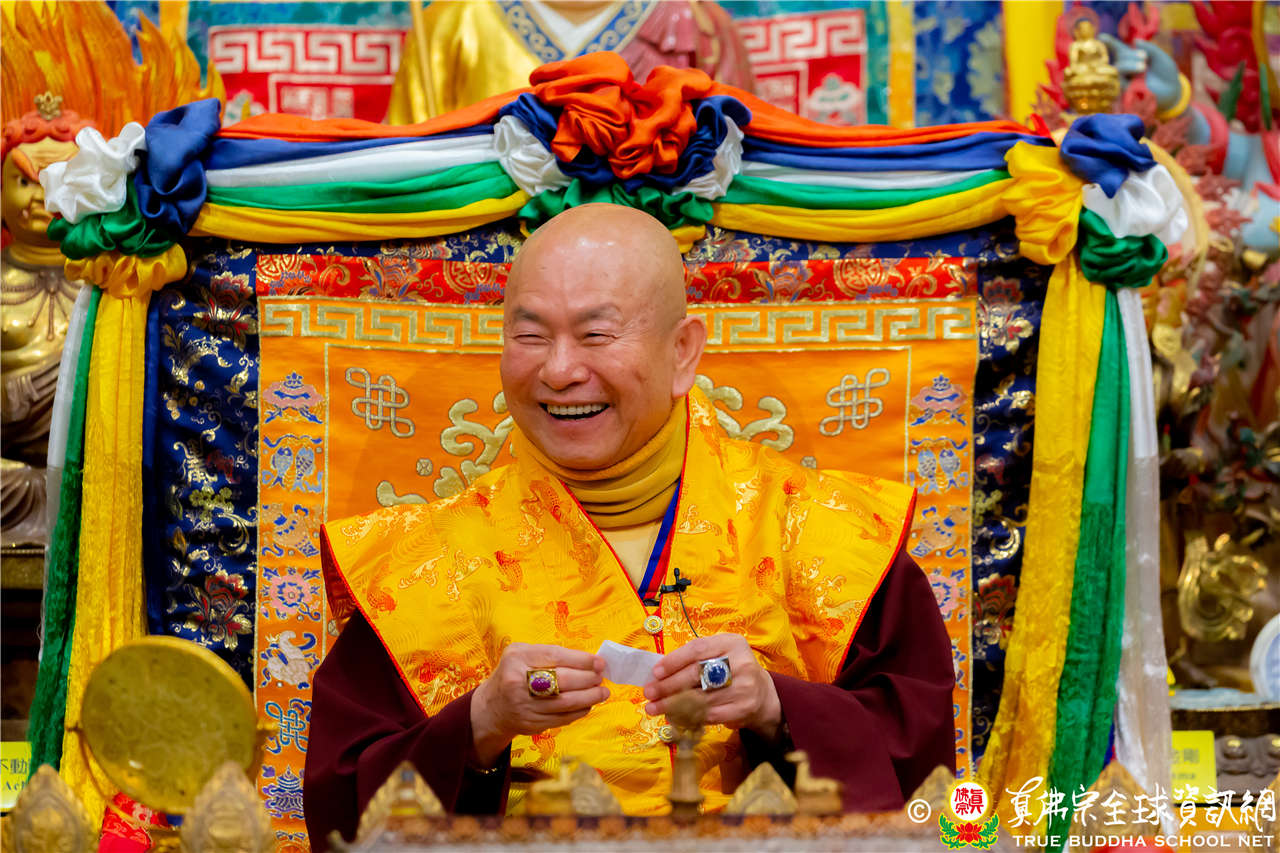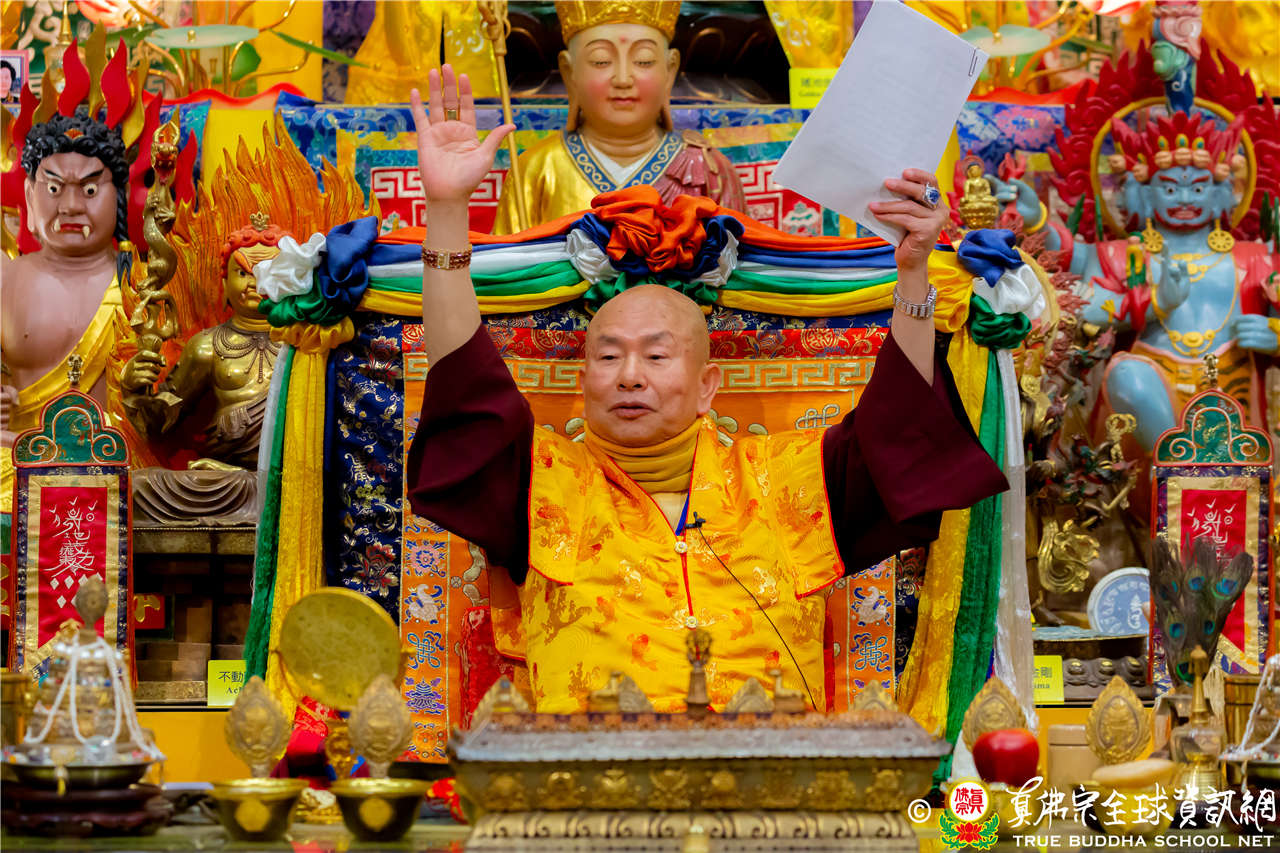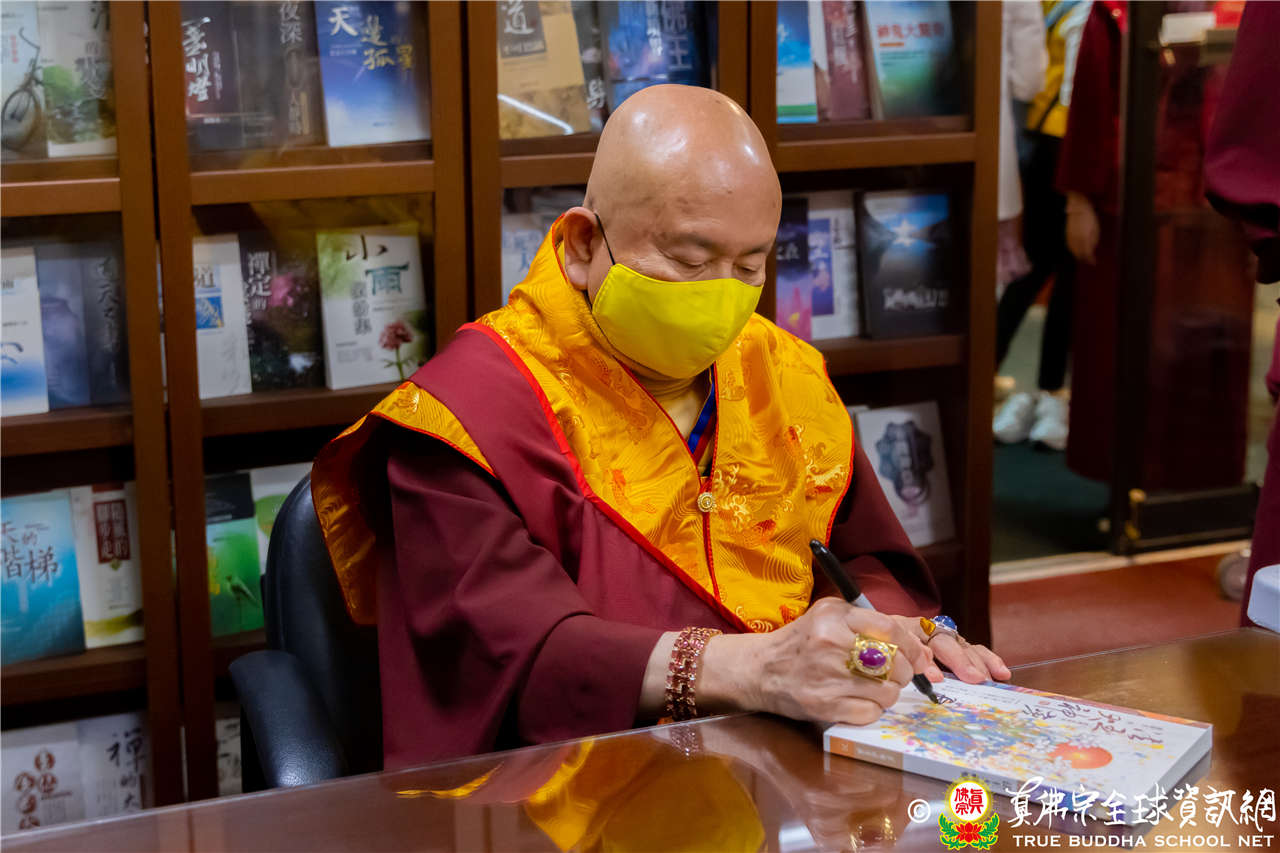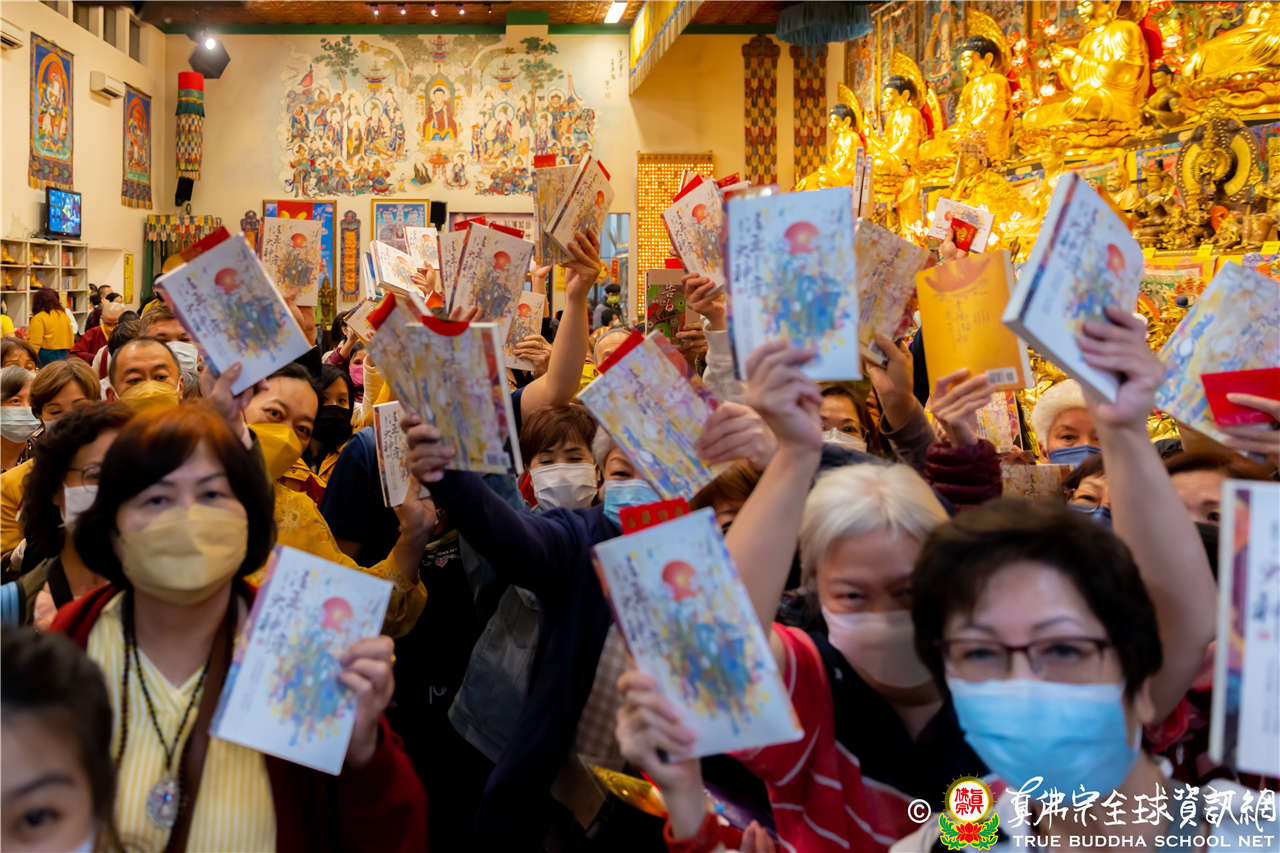
Vimalakirti Nirdesa Sutra
A Detailed Exposition by Living Buddha Lian Sheng, Grandmaster Sheng-Yen Lu
Translated into English by the True Buddha School Vimala Sutra Translation Team
Discourse 42, 15 October 2022 - Chapter One—Buddhaverse (Continued)
Chapter One—Buddhaverse
Precious Hand Bodhisattva,
Precious Seal Hand Bodhisattva,
Raising Hand Bodhisattva,
Lowering Hand Bodhisattva
Let’s now talk about the Vimalakirti Sutra:
Precious Hand Bodhisattva,
Precious Seal Hand Bodhisattva,
Raising Hand Bodhisattva,
There are four bodhisattvas with “hand” in their names—so, four hands here. A human has only two hands, though we say a pickpocket has three hands. The names of Precious Hand, Precious Seal Hand, Raising Hand, and Lowering Hand seemed to be translated word for word [from the original Sanskrit to Chinese]. Sometimes, you cannot translate words directly.
Recently, I read a book written by a Chinese Buddhist scholar, Lv Cheng, who talked about various translations of the Buddhist sutras. He mentioned the translators from Sanskrit to Chinese—Chen Zhendi, Xuan Zang,[1] and YiJing, as well as the Tibetans who translated from Sanskrit to Tibetan. These translations differ from each other.
According to Lv Cheng, there are direct translations and contextual translations. Yi Jing’s translation is a direct translation, meaning each word is translated literally. In direct translations, Sanskrit words are translated into Chinese word for word. On the other hand, Xuan Zang’s is a contextual translation; he translated the key meaning of a passage. Translating is really not easy, and it is no simple matter.
Let me give you an example: I often joke and say this Chinese phrase in English, “Your mother good!” which is a direct translation of nima ke hao. Its real meaning is neither a greeting for your mother nor asking whether she is well. Instead, it has an uncouth connotation. The translation of its meaning in context wouldn’t be something nice to say. There are many things we should not translate literally.
The Taiwanese say, “you eat full yet?” to greet each other. [This phrase is translated word for word to better convey this example.] This seemingly simple phrase can be translated into many different English sentences depending on the context because it means different things in different situations.
Literally, this greeting means, “Have you eaten and had enough food to your satisfaction?” [It implies you are all well.] But if you say this [direct translation] to someone walking out of the toilet, they would probably not like it. “Have you eaten?” In the toilet?! He might snap back at you, “Yes, I have! It’s your turn now!!” This phrase is a greeting and isn’t asking you about eating. [So, its English translation shouldn’t be “Have you eaten?” but perhaps, something like “Are you well?” or the plain and common greeting of “How are you?”] If a gangster greets another gangster, although they are saying the same words, it will mean something different, “Have you got nothing better to do with a full stomach?!” And it is no longer a greeting; he is picking a fight.
So, Xuan Zang would translate the meaning of this greeting, whereas Yi Jing would translate it literally. [The word-for-word translation would be “you eat full yet?”; a literal translation would be “have you eaten?”; a translation of the meaning would be “are you all well?” Both word for word and literal translations are considered direct translations.] The real meaning of the source language is lost in direct translations.
Languages are rich and profound, requiring great mastery to translate, especially the sutras. The monk Xuan Zang could translate the key meanings of the sutras, and this is called translating the meaning.
If I were to translate Precious Hand Bodhisattva literally, it would be a bodhisattva with a very precious hand. But that is not the real meaning. The real meaning is that he is a bodhisattva who frequently uses his hand to give blessings to sentient beings by touching their heads. Touching the head is giving blessings.
When a real bodhisattva—highly adept in his cultivation—gives blessings on your head, you will instantly gain wisdom and knowledge about your past lives. You will erase all your worries and afflictions and develop wisdom. If you have ailments in your body, like eye problems or shoulder pain, a light touch on those areas will immediately resolve them. This kind of bodhisattva is called the Precious Hand Bodhisattva. There is a meaning behind this name, and we should have translated the meaning. [His hand is precious because it can help sentient beings. Perhaps, his name can be translated as Helping Hand Bodhisattva.]
The literal translation of this name would be the Bodhisattva who has Precious Hands. Such a direct translation wouldn’t convey the meaning. It shouldn’t have been translated that way. Instead, we should understand the meaning and translate it accordingly. This bodhisattva uses his hands to bless sentient beings and alleviate their afflictions and sufferings. He can also enhance your wisdom by the touch of his hand—and you’d know about your past lives. [Perhaps a more appropriate contextual translation would be Blessing Hand Bodhisattva.]
Just now, we watched a video clip prepared by the True Buddha Wisdom Treasury (www.tbboyeh.org) talking about book number 291, The Miraculous Acts of the Dharma King, which is available for a book signing later. In the book, I wrote a story about touching the head of dharma sister Sherley Lin—nicknamed “waitress,” in our kitchen. Upon blessing, she had an incredible spiritual experience that night. All her past lives were vividly displayed before her eyes, all the way to Sakyamuni Buddha’s era. Precious Hand Bodhisattva can make such a phenomenon happen—so she can know her past lives.
The next one:
Precious Seal Hand Bodhisattva.
What do you mean by Precious Seal? Its direct translation means that this bodhisattva has a precious seal in his hand, or his hand is like a precious seal. But this name means that this bodhisattva comprehends the Three Dharma Seals—the ultimate truth spoken by the Buddha. “Seal” refers to the ultimate truth or ultimate reality—the unchanging truth that everything is impermanent.
The first truth states that everything is impermanent—nothing stays forever. Everything in the human world is everchanging. We, humans, are also everchanging. I look different from when I was in my twenties; I can show the old photo. Many people have seen it, and they all praised, “So handsome!” Some ladies blew kisses to the photo. But now, I am different. This is called change—impermanence. Humans can’t avoid change. From infancy to childhood, adulthood, middle age, and then to old age, we are all everchanging each day.
This applies to houses, too. Your house was new at first and gradually became old. Eventually, it will be demolished. You buy a new car, and after driving it for a few years, it becomes a second-hand car. Then it will become an old car and in the end, goes to the junkyard to be scrapped. The cars too, are changing. Everything is always changing, including Earth.
In the past, it rained a lot in Seattle in October, and it would be quite chilly. Today, thinking that it would be cold, I wore this. But look at “Ms. Lion Head” [nickname] from England, dressing very lightly! Please stand up and show yourself to everyone. She dressed for summer and I dressed for winter. Seattle weather has changed too! It is October, and it is not cold yet. It should be cold by now! Normally in autumn, it is windy and rainy for a month or two. But we have had no rain at all for months, and now there are forest fires.
The climate has changed—it has become warmer. The climate, the sky, the earth, the people—everything is everchanging. This is the seal of impermanence, and it is the ultimate truth.
The second truth is the absence of self—inherent nature—in everything. I ask Venerable Lian Shui, “Who are you?” [“Shui” means “who” in Chinese, so his name translated into English is Lotus Who.] So, where am I? Where is the past “self”? Where is the current “self”? Where is the future“self”? There is inherently no “self.” The “self” does not exist. I do not exist. The Buddha teaches that there is no “self” in everything.
You should often ponder, “Who am I, really?” I asked Lotus Who, “Who are you?” and in reply, he wrote a very good article, which I included in either book number 293 or 294. Be mindful of this question and know that you are everchanging and never stay the same, not for even one day. What is really going on with you? How about when you came into this world? Where is the past you? Where is the future you? You need to often question and ponder on this.
This is the absence of self (inherent nature) in everything, and this is the ultimate truth. Everything has no self-nature—no inherent nature. Everything is an aggregate, an amalgamation. Where is the inherent nature? You need to recognize where your original nature is.
For example, this table and chair are made of wood. Before they became a table and chair, they were wood, part of a tree. The toilet seat cover is also made of wood. Many Buddhist statues are also made of wood. Some are made of bronze. It was bronze before, and now they are statues. Bronze can also be made into a chamber pot that the elderly use to urinate in the middle of the night. They place the chamber pot by their bed, so they don’t need to go through the trouble of walking to the bathroom. These items are all bronze. One became a revered Buddhist statue, whereas another became a urinal. So, these things do not have any “self.” [Similarly, bronze also has no “self” as it can disintegrate into nothing.] This is the absence of inherent nature in everything.
The third truth is the phenomena of extinction in nirvana—which is essentially the empty nature. Everything transforms into emptiness. Thus, everything is unattainable. What can you attain? Nothing! This is unattainability—emptiness, extinction in nirvana. The Buddha says nirvana is extinction, referring to empty nature. Sentient beings are amid nirvana and amid extinction; they are intrinsically empty. Thus, extinction and nirvana are the empty nature.
The fourth truth is the seal of the one and only true phenomena. The real phenomena is empty nature, and empty nature is the real phenomena.
The above are the ultimate truths (seals) spoken by the Buddha. One who understands the precious seal of the ultimate truths and teaches them to sentient beings is called the Precious Seal Hand Bodhisattva.

The next one is:
Raising Hand Bodhisattva/the Bodhisattva who Always Salvage Sentient Beings.
Does “Raising Hand” mean that he always has his hands raised, even when sleeping or going to the toilet? Usually, one raises their hand to answer a teacher’s question. Is that what it means? So when you want to emulate the Raising Hand Bodhisattva, you raise your hand every day? Is that so? No, no! It wouldn’t be right to interpret it that way—that’s too literal.
The real meaning is that the Raising Hand Bodhisattva always saves and delivers sentient beings. He is the pole bearer of the tathagata’s work. With one or both hands, he carries the great work of the tathagata to salvage sentient beings. A direct translation into Chinese sounded like he is always raising his hand, whereas in fact, the Raising Hand Bodhisattva raises his hands to carry on the work of the tathagata. He uses buddhadharma to deliver sentient beings. Now, do you understand?
We need to know and explain its meaning instead of reciting or translating blindly without understanding. For instance, the names of the 52 bodhisattvas: Equal View Bodhisattva, Unequal View Bodhisattva, Equal and Unequal View Bodhisattva, Meditation Self-mastery King Bodhisattva, Dharma Self-mastery King Bodhisattva, Dharma Phenomena Bodhisattva, Light Phenomena Bodhisattva, Light Adorned Bodhisattva, Greatly Adorned Bodhisattva, Accumulated Treasures Bodhisattva, Accumulated Eloquence Bodhisattva, Precious Hand Bodhisattva, Precious Seal Hand Bodhisattva, Raising Hand Bodhisattva, Lowering Hand Bodhisattva, …
When you chant it, do you know what these names mean? Raising Hand Bodhisattva is not a bodhisattva who always raises his hands or is surrendering—raising both hands while walking out from hiding in the forest. Instead, his hands constantly carry out the work of the tathagata to deliver sentient beings using buddhadharma.
Next is:
Lowering Hand Bodhisattva.
With lowered hands, this bodhisattva meets and guides sentient beings to the purelands. The direct translation is the bodhisattva who always lowers his hand, like a pickpocket with his hand lowered into someone else’s pocket, especially when the targets are mindless on a bus. However, this is not the case!
Lowering Hand Bodhisattva always lowers his hands to receive and guide sentient beings. This is the mudra of the Buddha—extending his hand down to welcome sentient beings and guide them to the purelands. Now, do you understand its meaning? If someone asks what these names mean, then you can tell them that the Raising Hand Bodhisattva bears the salvation work of the tathagata while the Lowering Hand Bodhisattva guides sentient beings to the purelands.
Today we went through four bodhisattvas containing the word “hand” in their names. You should clearly understand it by now. Precious Hand Bodhisattva uses his hands to touch the heads of sentient beings to alleviate their difficulties and sufferings. Precious Seal Hand Bodhisattva understands the three dharma seals and uses his understanding to deliver sentient beings. Raising Hand Bodhisattva carries the great work of the tathagata. Lowering Hand Bodhisattva is the bodhisattva who always guides sentient beings to a better realm.
Now you understand the key meaning of these bodhisattvas.
Om mani padme hum.
[1] The famous monk Xuan Zang, also known as the Tripitaka Master from Tang China, was the protagonist in the Journey to the West. He went to India to seek dharma and to obtain the sutras.


Next discourse on the Vimalakirti Sutra: Discourse 43, 16 October 2022 - Chapter One—Buddhaverse (Continued)
Previous discourse on the Vimalakirti Sutra: Discourse 41, 9 October 2022 - Chapter One—Buddhaverse (Continued)
Index of links to all discourse on the Vimalakirti Sutra: https://en.tbsn.org/guidem/detail/2975/
Back to the main index page of all dharma discourse: https://en.tbsn.org/guidem/index
Full webcast of 2022.10.15 Yellow Jambhala Group Practice (Ling Shen Ching Tze Temple, Redmond, USA) and dharma discourse with English interpretation: https://youtu.be/0nG5FAn2naY




